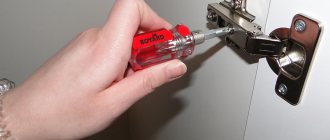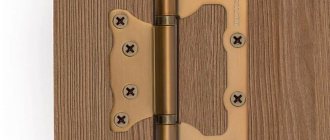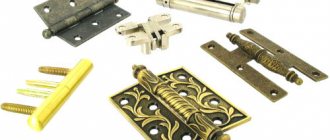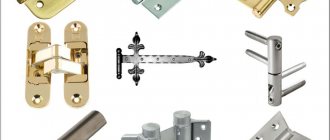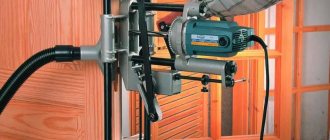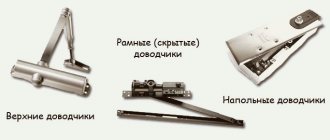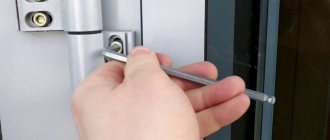Loops
One of the most important stages of installing door structures is installing hinges. At first it may seem that this process is not at all complicated - you just need to attach the hinges and hang the sash in the box. But in reality, in order for the installation of door hinges to be of high quality and correct, you will have to spend some time and effort. All actions must be careful and attentive. You will also need certain tools for installation. Before installing hinges on the door, you should consider the instructions and advice from experts.
Installation process
Installation of mortise hinges
It is easier to install hinges on interior doors yourself when the frame is not yet fixed in the opening.
This rule applies to the installation of standard fittings that require insertion. First, one part of the hinge is applied to the end of the sash. Using a pencil, outline the outline of the mounting plate and mark the location of the holes for the screws. Using the markings, select a recess using a chisel or milling cutter. A hole is drilled for the self-tapping screws. When all the preparatory work is completed, the fittings are fixed to the end of the sash. It is advisable to insert the hinges with a router, since the tool can accurately select the recess. The chisel results in chips or extra scraping. The depth is reduced with cardboard pads, but over time they deteriorate. The door begins to wobble and sag.
To continue inserting hinges into interior doors, the frame is placed horizontally. The canvas is placed inside the frame. Similar markings, as well as cutting out recesses, are made on the stand of the box for the reciprocal fastening part of the butterfly. When the fittings are securely fixed with self-tapping screws, place the door block vertically and try to open the door. If everything is fine, remove the canvas and begin installing the boat in the opening.
Benefits of hidden hinges
- You can adjust the loop even with the blade installed. No dismantling is necessary.
- The leaf is evenly adjacent to the door block. The same gap is maintained at all ends.
- The concealment of the design gives the interior door an attractive appearance.
- Thanks to the large opening angle of the doors, you can carry large objects through the doorway.
- The installed additional protection makes it impossible to remove the hidden part in order to remove the canvas.
- The special hinge design ensures reliability.
- A secure installation holds a heavy door without sagging.
Adjustment is carried out without removing the door leaf
Tools
To adjust the design of an interior door block, a standard set of tools and devices is required.
- Screwdriver.
- Hammer.
- Plumb.
- Chisel.
- Grease (a pencil lead will do instead).
- Plane.
Types of door hinges
Depending on the place of installation, door hinges are divided into hinges for entrance and interior doors. Based on the type of installation, hinges are divided into the following types:
- Detachable. To remove a door with such fastenings, you do not need to unscrew the hinges.
- Universal. To remove the doors, you will also have to remove the universal hinges.
Reinforced hinges for entrance and interior doors
The above is not a complete classification, because overhead door hinges are divided into three types according to their design:
- Invoices with insert (universal). Such hinges consist of two parts with holes, one is attached to the door leaf, the second to the door frame. They are often made of durable steel, so they are highly reliable and have a long service life.
- Overlays with insert (detachable). Complex installation, but easy installation and dismantling of the door leaf, as well as adjustment of the hinges themselves. As in the previous case, they are highly reliable and durable when used correctly.
- Invoices without insert (universal). They are easy and quick to install, do not cause problems during adjustment, cheap and reliable, and also the most popular.
Most often in practice, the above types of loops are used. More rarely, you can find screw-in and bar door hinges, as well as hidden ones that add reliability to the structure.
Such hidden loops will not allow unauthorized persons to break into
Where is it used?
Screw-in hinges are also called pin hinges; they are installed on doors with a hinged part (with a quarter). Instead of regular slats, they have small rods that are screwed into the block and the canvas.
The dimensions and weight of the door determine the choice of screw-in hinge model. For lightweight folding sashes and swing doors, you need to choose awnings with 2-3 rods. For large and heavy doors, hinges with four rods are used - such models are made of special steel and can withstand heavy loads.
The advantage of such fittings is easy adjustment using a hexagon. It can be adjusted in height or horizontally, as well as in the clamping area.
DIY replacement
A competent operation to replace the seal will require scissors and silicone glue.
Repair stages:
- Purchase a seal with the required parameters. This needs to be taken care of in advance. If necessary, visit a hardware store with a sample of the old gasket, where, with the help of a consultant, select an analogue.
- Removing the old seal from the groove using available tools. The operation must be performed carefully so as not to damage the canvas.
- Thorough cleaning of the grooves. Dirt will not allow the new insulation layer to be laid properly.
- Applying silicone glue to the corners. This will prevent the elastic from moving.
- Laying the insulation into the groove, starting from the attachment point of the old gasket. An even distribution is required, without sagging, folding or tension.
- Fastening the joint tightly. Sometimes the seal is cut at a 45 degree angle to ensure a tight fit at the end.
- Quality checking. Cold air should not penetrate into the room.
Poor closing
Poor or loose closing of interior doors can be caused by the following factors:
- The skew of the door frame is due to improper connection of the beams. Eliminated by more tightly fastening all components of the box using screws. To do this, the box must first be dismantled;
- Insufficient deepening of the hinges into the box is eliminated by tightening the screws securing the hinges. If this does not help, you need to remove the box and deepen the niches for the hinges;
- Excessive deepening of the hinges in the door can be solved by loosening their fasteners.
Article on the topic: Using 3D wallpaper in the living room, features of the material
This work is simple, but it requires certain skills in handling a screwdriver for tightening screws, a plumb line for determining the verticality of the surface, a hammer, a chisel and a plane for deepening the niches of the hinges. The video shows in detail how to adjust an interior door with hinges.
How can you determine for yourself that everything is normal?
The criteria for proper operation of door hinges are:
- easy, effortless opening/closing;
- uniform adhesion of the door leaf to the frame around the entire perimeter;
- maintaining a stable position;
- absence of any friction between the door and frame;
- precise operation of the clamping mechanism and, as a result, no gaps.
If at least one of the conditions is violated, this is a signal that the hinges need to be adjusted, as this affects both the service life and the operation of the door. If no measures are taken, then in the future this can lead to noticeable sagging or displacement of the canvas and the box relative to each other, which can lead to repair work of a completely different complexity and cost. And if small deviations are found, then this can be completely corrected either by specialists, or even on our own - you only need to make some adjustments and adjust the hinges.
How to properly adjust the hinges on a metal entrance door?
In the photo, adjusting the hinges of interior doors
Adjusting the locking mechanisms
The initial stage is disassembling the device. It will depend on the design features whether it will be necessary to dismantle the linings, locking mechanisms and remove the handles. The main method of adjustment and correction will be determined by the symptoms of malfunctions.
If the door lock is jammed, lubricate the latches with machine oil or grease. When lubricating, rotate them so that the liquid spreads throughout all the insides of the mechanism.
If the lock has a short hidden tongue, then there are adjustments for the extension of the tongue, which is built inside the handle. You can adjust the reach by rotating a screwdriver in a special groove. This applies to both the locking mechanism tongue and the handle tongue.
Cases in which adjustment is needed
A misaligned door frame always leads to unpleasant consequences. Sometimes it is necessary to call a qualified specialist to eliminate them. But in the vast majority of cases you can cope on your own. Therefore, we will figure out how to adjust plastic balcony doors with our own hands. But before we give step-by-step instructions, we list the most common malfunctions:
- Cold air passes through the vestibule areas.
- The door handle is tight or does not close completely.
- It takes a lot of effort to cover the canvas.
- The sagging frame clings to the box.
Fixing these problems takes no more than half an hour, so there is no point in postponing the work until later.
If the problem is in the mechanical part, in order to provide access to the adjusting screws, remove the decorative trims from the hinges.
In the vast majority of cases, a No. 4 hex and a Phillips screwdriver are sufficient for the job. Less commonly, you may need a #3 hex wrench, sprockets, pliers, or a flat-head screwdriver.
Before starting work, we recommend that you pay attention to the relative position of the canvas and the box. This will avoid unnecessary actions and install the elements in the correct position.
To do this, close the frame and outline its perimeter with a pencil. The resulting contour should be parallel to the inner edges of the door frame. If this is not the case, you need to adjust the plastic balcony doors yourself.
We will describe the procedure for dealing with common faults.
The canvas is sagging and catches the threshold
This problem is typical for wide, heavy structures with double-glazed windows. Additional load can be created by heavy bags hanging on the handle, or children who like to ride on the door wings. Often it is after this that they begin to sag.
The lower hinge allows you to lift the sash. We insert a hexagon into it from above and rotate it:
- clockwise - raise;
- counterclockwise - lower.
This helps with even sagging. If only one corner catches, it is necessary to eliminate the distortion.
To do this, we use the lateral adjustments of the upper and lower hinges. We rotate the screw with a hexagon: when turning to the right, the blade moves towards the key, to the left - in the opposite direction.
If the range of movement with the adjusting screws is not enough, the geometry of the PVC frame is corrected with pads under the glass unit. It is better to entrust this work to qualified specialists. They dismantle the glazing beads and install calibrated wedges according to the diagram. If the technology is not followed, the load on the glass is distributed unevenly, and it may burst.
The canvas touches the edge of the box or is not covered tightly
This problem can be encountered in the autumn-winter period if the fittings were moved away from the corner as much as possible. The frame deforms slightly and engages with the axles. To fix the problem, you need to move the sash horizontally
It is important to do this evenly and avoid distortion. The mechanism is adjusted in two places: on the upper and lower loop
Before you adjust the plastic balcony door yourself, you need to open it completely. This will provide convenient access to the mechanisms.
Sequentially rotate the screws of the upper and lower hinges. We control the moment when the pins stop clinging to the door frame. After this, the adjustment can be stopped. But it is better to achieve a position in which both edges of the sash are equidistant from the inner edge of the installation box. This can be easily checked by tracing the outline of the closed canvas with a pencil.
Overhead hinges for doors made of metal-plastic
Features of the adjustment.
If the door is equipped with an overhead hinge (one of the most common options), its adjustment can be made in both two and three planes, depending on the functional features. Vertical misalignment of up to 5 mm is eliminated by adjusting the adjusting screw using a hexagon. In order to get to it, you need to remove the decorative trim from the hinges.
If there is a need to raise or, conversely, lower the door, you should find another adjusting screw at the bottom end, hidden under the detachable strip. Using the key, the door is raised up to 5 mm or lowered by 1-2 mm. The screw at the top end allows adjustment to approximately 2 mm. And when a larger adjustment is needed, up to 5 mm, you will need to completely remove the door and part of the hinge attached to the frame and adjust it.
The latter option is mainly used for doors that open in three planes. And adjusting the hinges of interior doors made of metal-plastic does not require such complex work.
Iron door adjustment
When opening tightly
The reasons for a tight opening of an interior door may be:
- excessive deepening of loops
- swelling of the door leaf or frame.
In the first case, you will need to adjust the hinges, according to the algorithm of actions described in the previous paragraph, or reinstall the fastening elements.
Swelling of the canvas is a problem typical for wooden structures. To eliminate it, it is necessary to give the door its original geometric shape. The procedure consists of carefully removing part of the solid wood in problem areas using a plane. Then a layer of paint should be applied to the damaged surface.
Aluminum door hinges
The popularity of aluminum products is ensured by their beautiful aesthetic appearance, durability of the material, and low weight. Therefore, increased demands are placed on door hinges made from it, especially considering that, with rare exceptions, their adjustment is impossible. Of course, hot-pressed aluminum, which is used to make hinges, is a durable material with high wear resistance.
It is not recommended to install products made from low quality materials on these doors.
Even a slight impact of the door on the frame or slope can cause a crack or breakage. That’s why non-adjustable hinges are installed on such doors: if they are of high quality, they last a long time and reliably, but if they are of poor quality, they cannot be repaired, much less adjusted.
Metal-plastic doors
Such doors have few disadvantages. The box often becomes deformed, which requires adjustment of the hinge mechanism. The hinges begin to work poorly not because of the sagging of the fabric, but because of a malfunction of the hinge system.
Plastic doors are held on three hinges. They freely support the weight of the canvas. If there are only two of these mechanisms, and the installed fittings are of poor quality, the fabric may sag.
Adjustment of entrance and interior doors made of metal-plastic does not make any special differences. Only the thickness, determined by the opening method, as well as the number of chambers, is affected.
Possible causes of malfunctions
There are several main factors that cause problems or the need for adjustment of walk-through structures:
- installation of new sashes;
- violation of the geometry of individual elements;
- box deformation;
- poor fit of loops.
When a problem occurs, a characteristic symptom appears.
Which interior doors to choose for an apartment: types, description of advantages and reviews
Hidden interior door hinges
Hidden hinges are door fittings that are not visible because they are installed inside the structural profile. And although they were developed to prevent the entrance door from being broken into, such designs for fastening interior swing doors have become especially popular.
Adjustment of hidden door hinges is carried out using the same technology as similar fittings for entrance doors:
- You can raise or lower the canvas using screws located at the end of the hinge;
- sagging of the canvas is eliminated with a special long screw located under the decorative overlay, perpendicular to the hinge axis;
- The door pressure is adjusted by the locking pin.
It is worth noting that a correctly installed and adjusted door on hidden hinges can withstand the load much longer, without additional adjustments.
Modern manufacturers offer a wide variety of designs that have an aesthetic appearance and are highly durable and reliable. Thus, Simonswerk hinges can withstand loads of up to fifty kilograms. In addition, a special sliding system makes it possible to very rarely adjust Simonswerk door hinges.
Where is it used?
Screw-in hinges are also called pin hinges; they are installed on doors with a hinged part (with a quarter). Instead of regular slats, they have small rods that are screwed into the block and the canvas.
The dimensions and weight of the door determine the choice of screw-in hinge model. For lightweight folding sashes and swing doors, you need to choose awnings with 2-3 rods. For large and heavy doors, hinges with four rods are used - such models are made of special steel and can withstand heavy loads.
The advantage of such fittings is easy adjustment using a hexagon. It can be adjusted in height or horizontally, as well as in the clamping area.
Positive traits:
- different colors;
- complete with decorative caps;
- made of non-ferrous metal, mainly aluminum (plastic pin hinges are used for lightweight doors or windows);
- high wear resistance;
- beautiful appearance and compactness.
Among the disadvantages is the appearance of noise during operation, but models with a special plastic insert can solve this problem.
Screw-in mechanisms are universal - there is no need to choose for the left or right side. The canvas on such hinges cannot be removed, which can be attributed to both disadvantages and advantages.
The caps cover the rods and act as a decorative element. They are available in a variety of colors and can be chosen to suit any interior.
Door hanging technology
If you are going to hang a door, you need to start by securing the hinges to the door leaf. The top hinge is installed at a distance of 20 cm from the edge of the door, the bottom - at a level of 20 cm or 30 cm. If you need to secure three hinges, place the last one exactly in the middle between the first two. To install four hinges, divide the height of the door leaf into five equal parts and mark them with a pencil. The resulting four marking points will correspond to the future mounting location.
Only the upper component of the hinge needs to be mounted on the door leaf. The lower one will be attached to the door frame.
Attach the loop at the required distance to the end of the fabric. Using a building level, determine the horizon and mark it with a pencil. Using a chisel in the place where the loop will be attached, it is necessary to remove the top layer of the canvas (along the contour outlined in pencil). You don’t need to remove much - exactly the thickness of the loop.
Then you need to attach the canopy to the door leaf using self-tapping screws. To do this we use a screwdriver. If you don’t have such a tool, you can use a drill, turning it on for slow rotation. When using screws, you must pre-drill the holes
To do this, it is important to work with a drill with a diameter that is 1 mm smaller than the diameter of the screw. Thanks to this, the screw will fit tightly, ensuring reliable fastening of the hinge.
Now you need to mount the door into the frame, open it slightly and insert the lower component of the hinge. It should fit snugly into the box. Trace it with a pencil. This sequence must be followed when working with all remaining loops.
In the circled areas of the box you also need to remove the top layer with a chisel. The lower hinge covers will be inserted into these recesses in the future.
It is very important to ensure that the hinge pin is always in a horizontal position. Otherwise, the door will always open with resistance and jerking
If it is more convenient for you, you can slightly change the algorithm of actions. First, you can secure the lower components, then move on to installing the upper ones.
After securing the hinges, it is recommended to lubricate them with Vaseline, grease or machine oil if they creak. Use rubber or cardboard spacers under the hinges if you have worked a little more with the chisel than necessary.
https://youtube.com/watch?v=JmPbCAz81GQ
The washer between the hinge hinges will allow you to slightly “raise” the door. This will help in cases where it opens and closes with force, the door touches the carpet or scratches the floor.
If there are significant defects on the door leaf where the hinges are installed (for example, cracks or voids), the hinges must be moved. Be sure to move all hinges on the door.
Sometimes the screw does not fit tightly enough into the door leaf. This problem can also be solved very simply. Drill a screw, fill the hole with PVA glue and place a wooden dowel in it. When this structure is dry, you can reinsert the screw into the drilled dowel.
As you can see, hanging a door is a rather painstaking, but quite feasible task for almost any of us. Knowing some tricks, you can install it yourself without outside help. What secrets and useful techniques do you know that will help you hang doors? Be sure to share your comment under this article!
News
The interior door sagged: reasons, how to prevent and eliminate
Interior doors sag over time. How quickly depends on various factors: operating conditions, door design, leaf weight, quality of fittings and installation. In this article we will talk about common causes of sagging, how to prevent it, and in what cases you can fix the defect yourself.
How to understand that an interior door has sagged
You can determine that the interior door has sagged by these signs:
- the gap between the floor and the door will not be the same across the width of the door leaf
- Traces of contact with the door leaf remain on the floor or threshold; in advanced cases, the floor covering is damaged in these places
- A large gap appears between the door and the frame.
To correct a defect, you need to identify its cause.
Door hinges are sagging or deformed
This is the most common reason for sagging interior doors. The hinges become deformed when:
- they are incorrectly attached to the door leaf and door frame
- use cheap, low-quality fittings
- for a heavy door leaf, choose weak hinges
In all three cases, the load on the hinges exceeds the norm. Because of this, the fasteners become deformed or weakened, and the door sags.
Sometimes the problem can be easily resolved on your own - tighten the screws that secure the hinges. But this is effective if the door is light and the fastenings have recently become loose.
If the door has been sagging for a long time, most likely the holes are broken. To restore them, you need to remove the door from its hinges, fill the holes with durable material and screw in longer screws.
To strengthen the holes for the self-tapping screws, you need choppers greased with glue.
It is important that the glue dries - only then can you screw in the fasteners and hang the door leaf. Bent hinges are replaced with new ones.
You can do this yourself or invite a specialist.
Deformed door block
It is impossible to determine the deformation of the door block by eye. But you can do this with the help of available materials - for example, an even block the height of a box. It must be attached to the door frame on the side where the hinges are screwed. If there are gaps between the top and bottom corners, the box is deformed.
To correct the defect, the door block is strengthened. Then the top loop is moved a little higher, and the bottom loop a little lower.
Construction skills will be required. And if you don’t have them, call a professional.
Warp door frame
The misalignment of the door frame is considered one of the most complex defects: if measures are not taken in time, the frame posts may come out of the opening. There are two ways to detect a skewed door frame:
- using a plumb line
- measure angles.
How to install mortise door hinges
After this, you can begin installing the door hinges. In order to properly hang doors on hinges, the top hinge is attached at a distance of 175 cm from the top edge of the door, the bottom - 250 mm from the bottom edge. The hinges cut into the frame and into the vertical timber of the door leaf. The frame should be secured in the opening with wedges for a while, after which you need to mark the position of the hinge cards on the door and on the frame.
Then the wedges need to be removed and the door placed on its edge. The opened hinges are laid out with a map according to the markings so that the hinge slightly touches the edge of the door, and are outlined with a pencil.
Along the intended line with a chisel, you need to make several shallow notches across the grain to the thickness of the card and select the wood. Then you need to drill holes for screws through the holes in the hinges. Both hinges are attached to the door, after which it is installed in the open position so that the hinge cards are aligned with the marks on the door frame. Check that the hinge hinges are exactly parallel to the box and mark the exact position of the hinge cards on the box. Just like on the door leaf, select the wood where the hinges will be installed.
Now you can begin installing the door in the opening. To properly hang the door, insert one screw into the frame through the hinge card holes. Try opening the door - it should not rub against the door frame. Otherwise, you will need to deepen the hinge slots a little or place a thin sheet of cardboard under the cards. If the door is located symmetrically and moves freely without touching the frame, then all you have to do is tighten all the screws.
By the way!
There are mortise hinges that lift the door slightly when it is opened. This allows the door to close independently under its own weight. This also prevents the door from touching the carpet. These hinges consist of two parts: the first is the lower card with a fixed axis, which is installed on the door frame, and the upper card, which is installed on the door leaf. The upper part with a hinge is attached to the door and fits onto the lower part, fixed to the frame.
Other defects
Scratches and other deep defects are common in door structures in families with small children. Dents are common on public doors. Experts advise purchasing the substance Cosmofen at a hardware store. It is a liquid plastic that is used to treat the scratched surface.
Algorithm for eliminating defects:
- Clean the surface of the canvas using any household means.
- After complete drying, it is necessary to degrease the parts to be treated.
- Apply a thin layer of putty with a spatula.
- After drying, the surface is sanded with fine sandpaper.
- Depending on the door material, the door leaf is coated with matte or glossy varnish.
- For laminated options, use a special pencil that eliminates any defects.
If the problems are more serious, it is recommended to use the services of professionals.
Types of door hinges
There is a wide variety of door hinge models. They can be classified according to various criteria.
By place of application:
- hinges for doors installed at the entrance to a home, which are distinguished by their massiveness, since the leaf of this design has a lot of weight;
- lighter hinges used for interior doors that have a beautiful decorative appearance.
According to their design, loops are divided into the following types:
- overhead hinges are simply installed on the door leaf and screwed with screws; in this case, no additional preparation of parts of the structure is required;
- Mortise-type hinges are recessed into the door leaf and frame, so to install them you have to first cut out special grooves;
- screw-in hinges are used on quarter doors, but their use on fragile materials is impossible;
- corner hinges are also used on structures with a quarter, and provide a tighter connection of the canvas;
- hidden hinges are invisible on closed doors, but to install them you have to make a fairly deep cut;
- Double-sided hinges are used in special rooms where there is a need to open doors in both directions.
Device
Screw-in hinges have several elements:
- connecting pin;
- frame part for fixing in the opening;
- leaf part for fixing on doors.
Screw-in mechanisms with a nylon insert or ball are available for sale, which ensure noiselessness when closing and opening, and also reduce friction and help extend the service life of the fittings.
Pin hinges vary in size: small ones are used for installing windows, and large ones are used for doors.
Door mechanisms may have multiple pins. For windows and plastic doors, choose one with two rods, for light wooden doors - three, for massive and heavy panels - with four.
Screw-in mechanisms can be:
They differ in that doors with adjustable hinges after installation can be aligned vertically, horizontally, and also set the required gap between the leaves and the door block. As a result of the adjustments, you can achieve the easiest and most silent door movement during operation.
The kit may include caps or linings. Caps allow you not only to hide the hinges, but also to give the doors a beautiful look that harmoniously fits into the overall design of the room. Overlays are used to add elegance to the entire structure. Decorative elements also serve the purpose of increasing the service life of hinges, protecting them from possible mechanical damage and the adverse effects of dust, humidity and other factors.
Step-by-step instructions for setting up hinges
Adjustment of hidden door hinges is carried out many times until the creaking disappears.
This process is carried out as follows:
- Using a socket wrench, loosen the fastening of the hinges starting from the middle.
- After this, we pull the door leaf to the frame and tighten the nut from the edge.
- Then, with gentle movements, return the loops to their place, fixing them in this position.
- Control of the completed adjustment is carried out by repeatedly closing and opening the door.
If the hinges are worn out, it is very difficult to achieve the desired result using such actions, so the hinges will have to be replaced.
Device
Screw-in hinges have several elements:
- connecting pin;
- frame part for fixing in the opening;
- leaf part for fixing on doors.
Screw-in mechanisms with a nylon insert or ball are available for sale, which ensure noiselessness when closing and opening, and also reduce friction and help extend the service life of the fittings.
Pin hinges vary in size: small ones are used for installing windows, and large ones are used for doors.
Door mechanisms may have multiple pins. For windows and plastic doors, choose one with two rods, for light wooden doors - three, for massive and heavy panels - with four.
Screw-in mechanisms can be:
They differ in that doors with adjustable hinges after installation can be aligned vertically, horizontally, and also set the required gap between the leaves and the door block. As a result of the adjustments, you can achieve the easiest and most silent door movement during operation.
The kit may include caps or linings. Caps allow you not only to hide the hinges, but also to give the doors a beautiful look that harmoniously fits into the overall design of the room. Overlays are used to add elegance to the entire structure. Decorative elements also serve the purpose of increasing the service life of hinges, protecting them from possible mechanical damage and the adverse effects of dust, humidity and other factors.
Rubbing the canvas
If during operation the sash rubs against the frame, metal is visible from under the decorative coating, it needs to be adjusted.
In this case, the input adjustment is carried out as follows:
- Use a socket wrench to loosen the fastening of the middle canopies. You should also loosen the loop at which friction is observed.
- The canvas is moved to the side towards or away from the box. This depends on the direction in which the misalignment is detected. The end nut is then tightened.
- The sash is “rocked” a little until the hinges return to their original place.
- After this, tighten the fastening.
- Then you need to open and close the sash several times to check the effectiveness of the work done.
If the friction has decreased but remains, the procedure must be repeated. If the hinges are worn out significantly, adjustment will not help them. You need to buy new fittings.
How to care?
In order not to constantly walk around with a screwdriver and not deal only with adjusting cabinet doors, a number of maintenance measures are recommended.
- After collecting and installing furniture structures, preventive tightening of bolts on door hinges is carried out 2-3 times a year. This is the case when the cabinet is used infrequently. For intensive use, for example, of a kitchen unit, this is done at least once a month.
- Structures must be regularly inspected for distortions, various defects, deviations, and so on. Fix all problems in a timely manner.
- The adjusting mechanism needs to be lubricated - this way it will work better and last longer. For lubrication, use motor oil or another suitable product. After the procedure, the door must be shaken back and forth (closed and opened) so that the lubricant penetrates deeper into the device. If you lubricate the hinges at least once a year, the door will not creak or make other noises.
- You can protect the canopy with the help of an oil closer, which will completely close the adjustment mechanism, and under such a cap the bolts will become less loose.
Metal hinges are quite reliable; if used properly, they can last up to 15 or even more years.
There is one “disease” with kitchen sheds, especially cabinets located near gas stoves or hobs. A viscous tar-like substance is deposited on them - a product of gas combustion. This causes the hinges to stick, preventing the doors from opening normally.
Such places require special attention and should be cleaned as often as possible.
You can maintain the appearance of furniture facades in an attractive form without much difficulty or effort. It won’t take much time to deal with distortions in door structures, and even less time will be spent on inspections and prevention.
How to adjust cabinet doors and furniture in general, watch the video.
Caring for fittings
We have already understood how to install and adjust the hinges, but it is important to preserve these elements for a long time. You definitely need to be able to adjust and lubricate these components, this is what will help protect them from rapid wear.
Below are general recommendations for caring for hinges:
- The first adjustment of the hinge elements must be done after screwing them into place;
- The amount and frequency of subsequent care will depend on the intensity of use of furniture structures. If the doors do not open so often, then it will be enough to adjust the hinges 2-3 times a year; with frequent use, even 4 times may not be enough;
- be sure to regularly inspect the appearance of the front part of the cabinets; if distortions or a low level of the rebate are suddenly discovered, then it is necessary to make precise adjustments;
- In order for furniture fittings to maintain their quality for a long time, it is necessary to lubricate the hinges. Can be lubricated with motor oil with a mineral or synthetic composition;
- In order not to hear noises, and also not to feel difficulties when opening and closing cabinet doors, you need to lubricate all hinges with motor oil once a year.
Setting up hinges is not that difficult; the whole process will take on average no more than 10 minutes. But at the same time, it will help preserve the quality of the hinges and the entire structure for a long time. The main thing is that when adjusting the hinges, do not forget about the recommendations and proper care of the fittings.
How to install an interior door structure?
It is advisable to start installing the door by dismantling the old structure. First you need to dismantle the old door: open it and pull it up until it comes off its hinges. Next, remove the old box. To do this, you need to find and unscrew the nails holding it to the wall. After the nails are removed, you need to saw the box on one vertical side and pull it out of the opening.
We prepare the opening for the installation of a new door structure. In order to clean the surface for further work, you need to remove old insulation, fasteners and construction debris from the opening. If any damage occurs during dismantling, the defects must be corrected using a building mixture. After this, check the verticality of the opening with a level. If there is a deviation of more than 1 cm, then they are corrected with a hammer or chisel.
Sometimes in old houses you can find wooden blocks built into the wall in the opening; they need to be removed and the gap sealed with cement. In order to install the box in the doorway, it must be assembled. A door frame is a frame made of U-shaped or rectangular beams. Most often you have to assemble it along the door leaf. To do this, lay the canvas on the floor and cut the elements of the box along it, leaving gaps of 3-4 mm, then assemble it.
When installing a U-shaped door frame, a gap of approximately 12-15 mm is made between the floor and the lower edge of the leaf. After all measurements have been completed, mark the location of all door hardware. All prepared beams for the box are assembled into the desired position and fastened with self-tapping screws (3 pieces for each joint). To install the hinges in the places marked with a pencil, you need to cut three grooves with a chisel.
Secure the hinges to the canvas with self-tapping screws, and do the same on the door frame, without tangling the hinges! Next, install the box into the prepared opening. To begin with, insert it into place. To ensure that the structure does not warp, you will need to align it strictly vertically using a level or plumb line. After this, the box must be secured with anchor bolts or self-tapping screws with a dowel.
For good fastening, you can insert three self-tapping screws on each side. Next, fill the voids with foam. After the foam has hardened, the excess is cut off with a mounting knife. The last stage is to fix the platbands. They are cut at joints at 45 degrees. For fastening, the platbands are either placed on special glue or on nails without heads.
Peculiarities
Hidden hinges are a structure consisting of a metal body, a hidden hinge located inside this body, a lever and an anti-friction bushing designed for better sliding.
The lever, in turn, consists of 2 parts connected to each other using a movable axis made of steel and providing a connection between the hinges and the blade. There are three types of hidden hinges: left-handed, right-handed and universal. And if the latter are able to function when installed on any side of the canvas, then the first two types have a narrow specialization and can only be installed on a certain side. Internal hinges provide 180-degree mobility of the blade and can withstand up to 200,000 opening-closing cycles. In addition, the devices ensure easy and silent movement of the door leaf, prevent the door from spontaneously moving away from the frame and have the ability to fix it in extreme positions.
The material used to make hidden door awnings is an alloy called tsamak, which contains aluminum, magnesium, copper and zinc. Tsamak is absolutely safe for the health of others and is highly durable and wear-resistant. The alloy casts well at fairly low melting temperatures and is characterized by a smooth surface and uniform structure.
Finished products are coated with chrome, brass plated or remain matte. This allows us to produce models in a wide range of designs and colors, which greatly simplifies the choice when purchasing them.
Hinges for heavy metal doors are made of high-alloy steel. The metal has significantly greater strength than alloy and is able to withstand heavy weight loads. In addition, steel hinges do not corrode and are highly resistant to extreme temperatures. This allows you to install internal loops on garages, warehouses and on the entrance groups of private and apartment buildings.
Hidden hinges are an indispensable type of door hardware when installing overlapping doors (with a quarter). The peculiarity of such systems is the method of attaching the door leaf to the door frame, which can be made in the form of a quarter on the door leaf and a counter quarter on the frame, or a quarter made only on the door leaf and forming an overlapping rebate when closing. The design features of the door block do not require the use of classic hinges and are designed only for the installation of internal fittings.
Installing different models of handles with your own hands
Installation of a stationary handle
It doesn't take much time to install a stationary handle. If the model is overhead, it is simply screwed to the door leaf with self-tapping screws; for this purpose there are holes in the base. The through model involves preparing a hole into which a threaded pin is inserted, and handles are screwed onto it on both sides. If a handle breaks, you simply need to replace it.
Installing the Latch Handle
To work, you will need a drill with a set of feather drills, a tape measure, a pencil, and a chisel.
Latch Handle Installation Tools
The sequence of work is as follows:
- We mark the place for attaching the handle at the selected height (from 80 to 120 cm from the floor). To do this, measure the distance from the square to the front plate and measure it from the edge of the door. At the end of the door at the same height, mark a point in the center.
- Using a drill and a feather drill of the required diameter, we prepare holes for the square and fasteners. You can make one large hole using a crown, but some models have additional screws that secure the structure to the door leaf, and in this case there will be nowhere to attach them.
- Using a chisel, we make a recess for the face plate. We first deepen the point at the end with an awl.
- Using a feather drill with a diameter of approximately 23 mm, we make a hole of the required length for the latch mechanism.
- We put the latch in place and fasten the face plate.
- We install the square pin and screw the handles onto it. Place the decorative base and tighten the locking screw.
Components of a lever handle with a latch
- On the box, we make a hole for the tongue with a chisel (to accurately determine the location, smear the tongue with oil or toothpaste and turn the closed door handle several times). After this, use a chisel to make a recess for the striker plate and fasten it with screws.
Installing a handle-lock
If a mortise lock with a handle is installed, installation is done a little differently:
- At the end of the door we mark the side contour of the lock. To do this, you can simply circle it.
Components of a mortise lock with a lever handle
- Using a drill and a feather drill of the required diameter, we make round holes close to each other. The depth should correspond to the width of the lock. We take out the outline with a chisel, the lock should fit completely into the hole.
- Using a chisel, we recess the face plate.
Recesses in the end of the door for the lock and face plate
- We make holes for handles and a keyhole.
- We install the square pin and screw the handles.
- If the base is a plank, it should be recessed a little.
- The strike plate is mounted in the same way as for the latch handle, only an additional hole is needed for the lock latch.
You can see the process of inserting the handle-lock in more detail in the video.
Installing a handle on a metal door
If you have already installed a lock on a metal door, installing the handle will not be difficult. The installation process will be the same as for a wooden door, you will only need special tools for drilling into metal. A metal drill will do an excellent job with holes up to 20mm; for larger holes you will need, for example, a cone drill.
Installing a handle on a metal door
Installing a double-sided handle on a plastic door
A plastic door is usually already equipped with technological holes for attaching a handle. We disassemble the handle: turn the decorative plug horizontally and unscrew one handle. First, a square with a handle attached to it is installed, and a second handle is attached to the other side. There are mounting bolts above and below the center that need to be tightened. The last step is to turn the plug masking the fastener into a vertical position. You can also install a lock for a plastic door yourself.
Handle for office, balcony and terrace plastic doors
Big gap
The complete opposite of the previous defect is an overly wide shutter. Even in a fully closed position, there remains a gap between the door and the hatch. The main cause of this problem is the thinning of the seal during prolonged use. If this is indeed the case, the rubber band needs to be replaced. Before gluing a new tape, make sure that the gap around the entire perimeter is the same; if there are places where it is wider, you need to use an additional lining.
Often the problem of a large gap is solved by replacing the old, thinned seal with a new one
Another reason could be a similar defect, as with a tight shutter. How to adjust the backlash of an aluminum door if the tongue and the hole for the bolt entry do not match? In this case, you need to bend the antennae of the plate to a position that will ensure a tighter fit of the door to the frame. Less often, the situation can be corrected by adjusting the tension of the door sash by tightening the hinges. From time to time it is recommended to check the position of the door and adjust it.
Timely adjustment of metal doors, done by yourself, is the key to long service life of the structure, protection from breakdowns and ensuring safety for all residents of the house.
Types of canopies
A variety of door hinges allows you to choose which way the door will open
Therefore, in order not to regret the decision after its installation, it is important to decide in advance on the type and principle of operation of the hinges
Butterfly loops
They are the most practical for interior doors. Butterfly loops got their name because of their characteristic shape - when open, they resemble the wings of a butterfly. When folded, the canopy is one card thick. This is achieved thanks to a special shape ─ when closing, one “wing” of the butterfly is precisely marked into the cutout of the second.
When installing such hinges, it is very important to select suitable screws. Since the two parts of the butterfly’s “wings” will be in direct contact with the wood, you should use screws whose caps will be ideally hidden in a special groove in the hinge
With the right choice, the sash will close well and no additional difficulties will arise during its use.
Experts do not recommend installing butterfly canopies on large and medium-heavy doors, since the thin metal and the very openwork of the structure are more suitable for using them as a decorative element.
Simple mortise
This is the most widely known type of awning. It is used in almost every home. It consists of two parts and is secured with ordinary wood screws.
Invoices
Structurally, they are not much different from the previous ones, but there are still some differences. The main nuance that should be taken into account when installing these canopies is the installation method. If the previous option is simply attached to the end of the door, then for this type of hinges it is necessary to make special recesses (embed in). This is necessary in order to hide the fastening plates and create a smaller gap between the door frame and the jamb.

